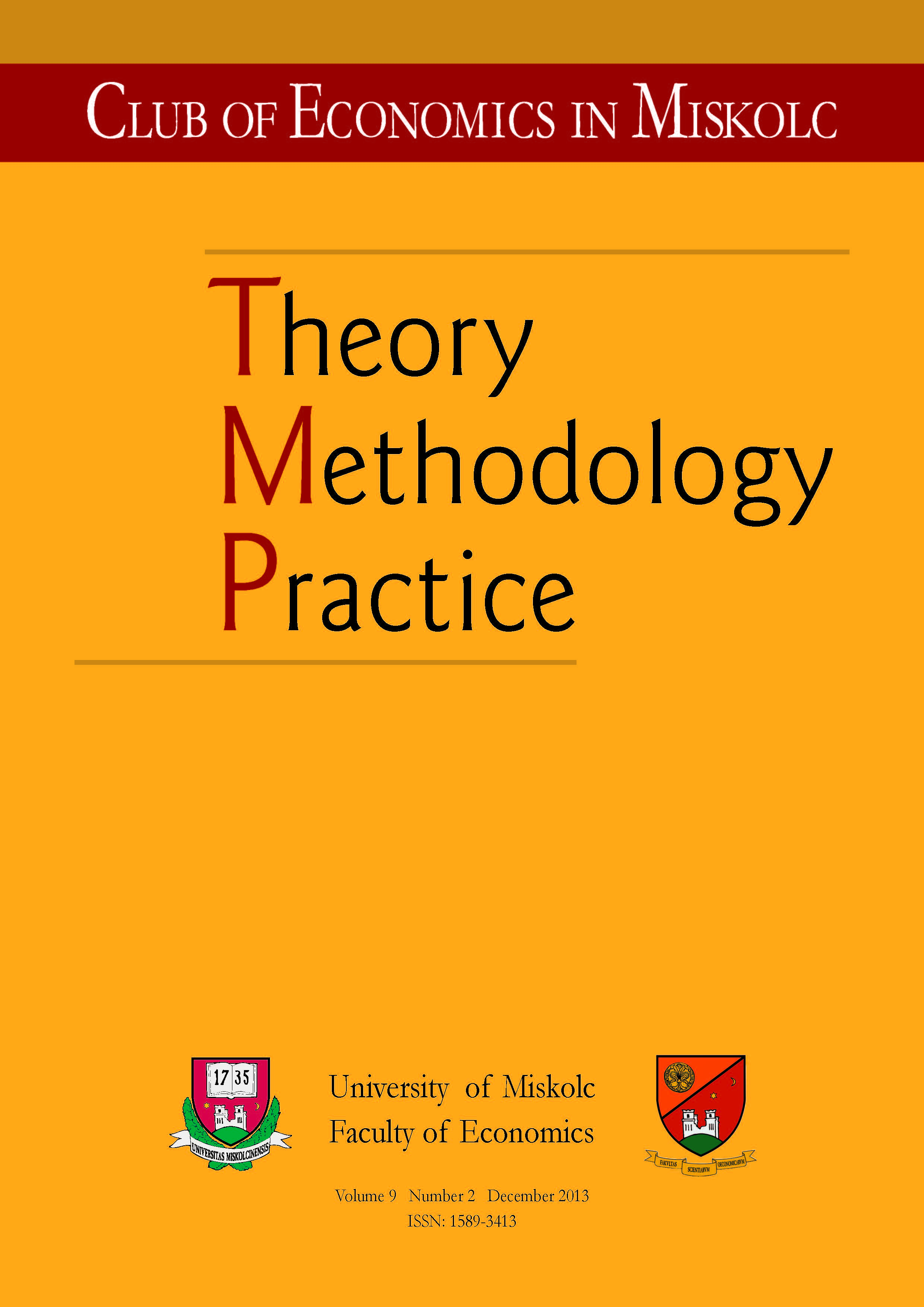Characteristics of the Dual Model among the OECD Countries
Keywords:
development models, FOI model, dual modelAbstract
Deciding on the development path of the economy has been a delicate question in economic policy, not least because of the trade-off effects which immediately worsen certain economic indicators as steps are taken to improve on others. The paper offers help to decide on such policy dilemmas, based on an analysis conducted among OECD countries with the FOI model (focusing on the future, outside and inside potentials). Several development models can be deduced with this method, from which only the dual model is discussed in detail. The dual model implies a development strategy focused on the attraction of outside resources, the instruments of which are also presented. The findings presented in the paper are part of a large OTKA (Hungarian Scientific Research Fund) study, which develops step by the step the methodology of the FOI model and discusses all of the development models found among OECD countries.
References
BALOGH, T. (1963): Unequal Partners 1-2. Blackwell, Oxford.
BARRO, J.B. (1998): Determinants of Economic Growth: A Cross-Country Empirical Study. MIT Press Books, Cambridge, Massachusetts.
BARTHA, Z., GUBIK, S. A. &TÓTHNÉ SZITA, K. (2013): Intézményi megoldások, fejlődési modellek (Institutional solutions, development models). GNR Szolgáltató és Kereskedelmi Bt., Miskolc.
BHAGWATI, J. (1958): Immiserizing Growth: A Geometrical Note. The Review of Economic Studies, 25(3), pp 201-205.
BOEKE, J.H. (1953): Economics and Economic Policy of Dual Societies. Institute of Pacific Relations, New York.
COASE, R.H. (1937): The Nature of the Firm. Economica 4(16), pp 386-405.
DOMAR, E. (1947): Expansion and Employment. American Economic Review, 37(1), pp 343-355.
EMMANUEL, A. (1972): Unequal Exchange: A Study of the Imperialism of Trade. Monthly Review Press, New York.
FREEMAN, C. (1987): Technology Policy and Economic Performance: Lessons from Japan. Pinter Publishers, London.
FURTADO, C. (1970): Economic Development of Latin America. Cambridge University Press, London.
HAMILTON, A (1791): Report on Manufactures. Philadelphia.
HARROD, R.F. (1948): Towards a Dynamic Economics. MacMillan, London.
HODGSON, M.H. (2006): What Are Institutions? Journal of Economic Issues, 40(1), pp 1-25.
KEYNES, J.M. (1936): The General Theory of Employment, Interest and Money. MacMillan, London.
KRUEGER, A.O. (1974): The political economy of the rent seeking society. American
LIST, F (1841): Das Nationale System der Politischen Ökonomie. Cotta'schen Verlag, Stuttgart.
LUCAS, R.E. (1988): On the Mechanics of Economic Development. Journal of Monetary Economics, 22(1), pp 3-42.
MARSHALL, A. (1890): Principles of Economics (First Edition ed.). Macmillan, London.
MCCLELLAND, D.C. (1957): Community development and the nature of human motivation. Harvard University, Cambridge.
MEIER, G.M. (1964): Leading Issues in Economic Development. Oxford University Press, New York.
MYRDAL, G. (1957): Economic Theory and Underdeveloped Regions. Gerald Duckworth, London.
NORTH, D.C. (1993): Institutions, institutional change and economic performance. Cambridge University Press, Cambridge.
PORTER, M.E. (1990): The Competitive Advantage of Nations. Harvard Business Review, 68(2), pp 73-91.
PREBISCH, R. (1964): Towards a new trade policy for development. United Nations, New York.
RICARDO, D. (1817): On the Principles of Political Economy and Taxation. John Murray, London.
ROMER, P. (1986): Increasing Return and Long Run Growth. Journal of Political Economy, 94(5), pp 1002-1037.
SCHUMPETER, J.A. (1934): The Theory of Economic Development: An Inquiry Into Profits, Capital, Credit, Interest, and the Business Cycle. Harvard University Press, Cambridge.
SIMON, H.A. (1957): Models of Man. Wiley, New York.
SINGER, H.W. (1964): International Development: Growth and Change. McGraw-Hill, New York.
SMITH, A. (1776): Enquiry into the Nature and Causes of the Wealth of Nations. J. R. McCulloch, Edinburgh.
SOLOW, R. (1956): A Contribution to the Theory of Economic Growth. Quarterly Journal of Economics, 70(1), pp 65-94.
SZENTES T. (2011): Fejlődés-gazdaságtan (Development economics). Akadémiai Kiadó, Budapest.
TULLOCK, G. (1967): The Welfare Costs of Tariffs, Monopolies and Theft. Western Economic Journal, 5(3), pp 224-232.
TULLOCK, G. (1993): Rent Seeking. Edward Elgar Publishing, Brookfield.
VEBLEN, T. (1919): The Place of Science in Modern Civilization. B. W. Huensch, New York.
WALLERSTEIN, I. (1974): The Modern World System: Capitalist Agriculture and the Origins of the European World Economy in the Sixteenth Century. Academic Press, New York.
WILLIAMSON, O.E. (1998): Transaction Cost Economics: How It Works; Where It Is Headed. De Economist, 146(1), pp 23-58.
WILLIAMSON, O.E. (2000): The New Institutional Economics: Taking Stock, Looking Ahead. Journal of Economic Literature, 38(3), pp 595-613.









